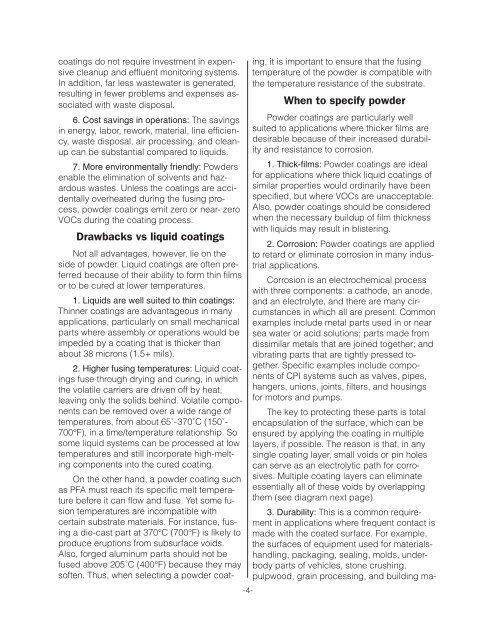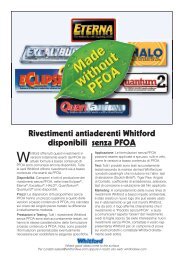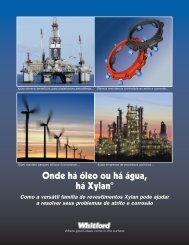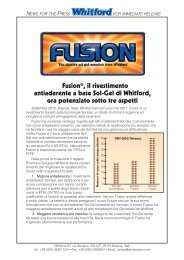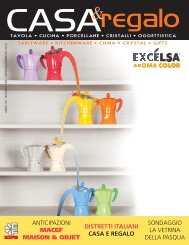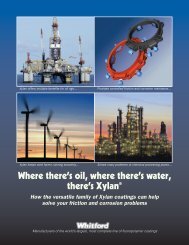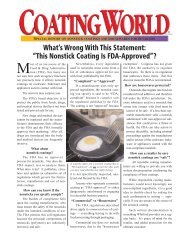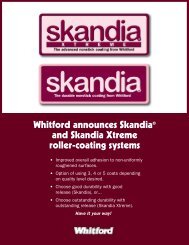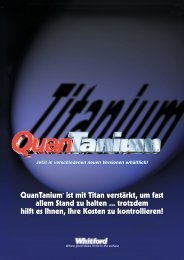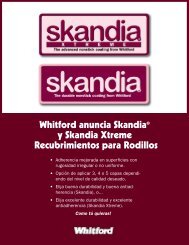Layout 1
Layout 1
Layout 1
You also want an ePaper? Increase the reach of your titles
YUMPU automatically turns print PDFs into web optimized ePapers that Google loves.
coatings do not require investment in expensive<br />
cleanup and effluent monitoring systems.<br />
In addition, far less wastewater is generated,<br />
resulting in fewer problems and expenses associated<br />
with waste disposal.<br />
6. Cost savings in operations: The savings<br />
in energy, labor, rework, material, line efficiency,<br />
waste disposal, air processing, and cleanup<br />
can be substantial compared to liquids.<br />
7. More environmentally friendly: Powders<br />
enable the elimination of solvents and hazardous<br />
wastes. Unless the coatings are accidentally<br />
overheated during the fusing process,<br />
powder coatings emit zero or near- zero<br />
VOCs during the coating process.<br />
Drawbacks vs liquid coatings<br />
Powder coatings are particularly well<br />
suited to applications where thicker films are<br />
desirable because of their increased durability<br />
and resistance to corrosion.<br />
1. Thick-films: Powder coatings are ideal<br />
for applications where thick liquid coatings of<br />
similar properties would ordinarily have been<br />
specified, but where VOCs are unacceptable.<br />
Also, powder coatings should be considered<br />
when the necessary buildup of film thickness<br />
with liquids may result in blistering.<br />
2. Corrosion: Powder coatings are applied<br />
to retard or eliminate corrosion in many industrial<br />
applications.<br />
Corrosion is an electrochemical process<br />
with three components: a cathode, an anode,<br />
and an electrolyte, and there are many circumstances<br />
in which all are present. Common<br />
examples include metal parts used in or near<br />
sea water or acid solutions; parts made from<br />
dissimilar metals that are joined together; and<br />
vibrating parts that are tightly pressed together.<br />
Specific examples include components<br />
of CPI systems such as valves, pipes,<br />
hangers, unions, joints, filters, and housings<br />
for motors and pumps.<br />
The key to protecting these parts is total<br />
encapsulation of the surface, which can be<br />
ensured by applying the coating in multiple<br />
layers, if possible. The reason is that, in any<br />
single coating layer, small voids or pin holes<br />
can serve as an electrolytic path for corrosives.<br />
Multiple coating layers can eliminate<br />
essentially all of these voids by overlapping<br />
them (see diagram next page).<br />
3. Durability: This is a common requirement<br />
in applications where frequent contact is<br />
made with the coated surface. For example,<br />
the surfaces of equipment used for materialshandling,<br />
packaging, sealing, molds, underbody<br />
parts of vehicles, stone crushing,<br />
pulpwood, grain processing, and building ma-<br />
-4-<br />
Not all advantages, however, lie on the<br />
side of powder. Liquid coatings are often preferred<br />
because of their ability to form thin films<br />
or to be cured at lower temperatures.<br />
1. Liquids are well suited to thin coatings:<br />
Thinner coatings are advantageous in many<br />
applications, particularly on small mechanical<br />
parts where assembly or operations would be<br />
impeded by a coating that is thicker than<br />
about 38 microns (1.5+ mils).<br />
2. Higher fusing temperatures: Liquid coatings<br />
fuse through drying and curing, in which<br />
the volatile carriers are driven off by heat,<br />
leaving only the solids behind. Volatile components<br />
can be removed over a wide range of<br />
temperatures, from about 65˚-370˚C (150˚-<br />
700°F), in a time/temperature relationship. So<br />
some liquid systems can be processed at low<br />
temperatures and still incorporate high-melting<br />
components into the cured coating.<br />
On the other hand, a powder coating such<br />
as PFA must reach its specific melt temperature<br />
before it can flow and fuse. Yet some fusion<br />
temperatures are incompatible with<br />
certain substrate materials. For instance, fusing<br />
a die-cast part at 370°C (700°F) is likely to<br />
produce eruptions from subsurface voids.<br />
Also, forged aluminum parts should not be<br />
fused above 205˚C (400°F) because they may<br />
soften. Thus, when selecting a powder coating,<br />
it is important to ensure that the fusing<br />
temperature of the powder is compatible with<br />
the temperature resistance of the substrate.<br />
When to specify powder


